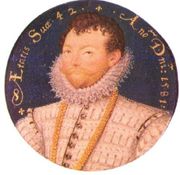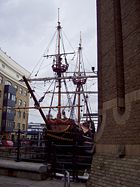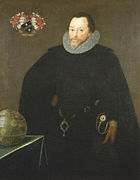Francis Drake
2008/9 Schools Wikipedia Selection. Related subjects: British History 1500-1750; Historical figures
| Sir Francis Drake | |
|---|---|
| February-March 1540 – January 27, 1595 | |
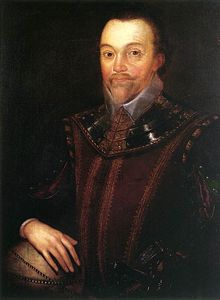 A 16th century oil on canvas portrait of Sir Francis Drake in Buckland Abbey, painting by Marcus Gheeraerts the Younger. |
|
| Nickname: | El Draque ("The Dragon") |
| Type: | Privateer |
| Place of birth: | Tavistock, Devon, England |
| Place of death: | Portobelo, Colón, Panama |
| Allegiance: | England |
| Years of service: | 1563 – 1595 |
| Rank: | Vice Admiral |
| Base of Operations: | Caribbean Sea |
| Commands: | Golden Hind (previously known as Pelican) |
| Battles/wars: | Anglo–Spanish War (1585) Battle of Gravelines |
Sir Francis Drake, Vice Admiral, (c. 1540 – January 27, 1595) was an English privateer, navigator, slave trader, and politician of the Elizabethan era. Drake was knighted in 1581 by Queen Elizabeth I. He was second-in-command of the English fleet against the Spanish Armada in 1588, subordinate only to Charles Howard and the Queen herself. He died of dysentery after unsuccessfully attacking San Juan, Puerto Rico in 1595.
His exploits were semi-legendary, making him a hero to the English but a simple pirate to the Spaniards. He was known as "El Draque" (from the old Spanish meaning "the Dragon" derived from the Latin draco, meaning 'serpent', an obvious play on his family name which in archaic English has the same etymological root) for his actions. King Philip II was claimed to have offered a reward of 20,000 ducats (about £4m or $8m by modern standards) for his life.
Birth and early years
| “ | The people of quality dislike him for having risen so high from such a lowely family; the rest say he is the main cause of wars. | ” |
|
—Gonzalo González del Castillo in a letter King Philip II 1592. |
||
Francis Drake was born in the parish of Crowndale, a mile south of Tavistock, Devon, in February or March 1540. He was the eldest of the twelve sons of Edmund Drake (1518–1585), a Protestant farmer who later became a preacher, and his wife Mary Mylwaye. The elder Drake is sometimes confused with his nephew John Drake (1573–1634), who was the son of Edmund's older brother, Richard Drake. (cf. John White, note 2). Francis Drake's maternal grandfather was Richard Mylwaye. Francis Drake married 1: Mary Newman; married 2: Elizabeth Sydenham (m.2 Sir William Courtenay of Powderham)1585.
Francis was reportedly named after his godfather Francis Russell, 2nd Earl of Bedford, and throughout his cousins' lineages are direct connections to royalty and famous personages, such as Sir Richard Grenville, Ivor Callely, Amy Grenville and Geoffrey Chaucer. However, James Froude states, "He told Camden that he was of mean extraction. He meant merely that he was proud of his parents and made no idle pretensions to noble birth. His father was a tenant of the Earl of Bedford, and must have stood well with him, for Francis Russell, the heir of the earldom, was the boy's godfather."
As with many of Drake's contemporaries, the exact date of his birth is unknown and could be as early as 1535, the 1540 date being extrapolated from two portraits: one a miniature painted by Nicholas Hilliard in 1581 when he was allegedly 42, the other painted in 1594 when he was alleged to be 53.
During the Prayer Book Rebellion of 1549, the family was forced to flee to Kent. Before he turned thirteen, Drake started his sea career when he became an apprentice member of the crew of a bark trading between the Thames and the cross-Channel ports. He became owner-master of the ship at the age of twenty after the death of its previous captain, who bequeathed it to him. At age twenty-three, Drake made his first voyage to the New World, sailing, in company with his second cousin, Sir John Hawkins, on one of a fleet of ships owned by his relatives, the Hawkins family of Plymouth.
In 1569 he was again with the Hawkins fleet when it was trapped by the Spaniards in the Mexican port of San Juan de Ulua. He escaped along with Hawkins but the experience is said to have led him to his lifelong revenge against the Spanish.
Circumnavigating the world
Entering the Pacific
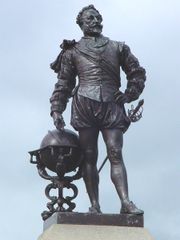
In 1577 Queen Elizabeth sent Drake to start an expedition against the Spanish along the Pacific coast of the Americas. He set out from Plymouth on the November 15, 1577, but bad weather threatened him and his fleet, who were forced to take refuge in Falmouth, Cornwall, from where they returned to Plymouth for repair. After this major setback, he set sail once again on December 13, aboard the Pelican, with four other ships and 164 men. He soon added a sixth ship, the Mary (formerly Santa Maria) which had been captured off the coast of Africa from the Spaniards. More importantly, he added its captain, Nuno de Silva, a man with considerable experience navigating in South American waters.
Drake's fleet suffered great attrition; he scuttled both the Christopher and the flyboat Swan due to loss of men on the Atlantic crossing. At San Julian, Argentina, the Mary was found to be rotten and was burned. After the trial and execution of Thomas Doughty, Drake decided to remain the winter in San Julian before attempting the Straits of Magellan.
The three remaining ships of his convoy departed for the Magellan Strait, at the southern tip of South America. The strait is named after the Portuguese navigator who first circumnavigated the world in 1521. This course established " Drake's Passage" but the route south of Tierra del Fuego around Cape Horn was not discovered until 1616. Drake crossed from the Atlantic to the Pacific through the Magellan Strait. After this passage a storm blew his ship so far south that he realised Tierra del Fuego was not part of a southern continent, as was believed. This voyage established Drake as the first Antarctic explorer, because the southernmost point of his voyage was at least 56 degrees according to astronomical data quoted in Hakluyt's "The Principall Navigators" of 1589. Until James Cook's voyage of 1773, this was the furthest south any seafaring explorer had ventured.
A few weeks later Drake made it to the Pacific, but violent storms destroyed one of the ships and caused another to return to England. He pushed onwards in his lone flagship, now renamed the Golden Hind in honour of Sir Christopher Hatton (after his coat of arms). The Golden Hind sailed north along the Pacific coast of South America, attacking Spanish ports and rifling towns. Some Spanish ships were captured, and Drake used their more accurate charts.
In one of his most notable actions, Drake captured a Spanish ship, laden with riches from Peru, which held 25,000 pesos of pure gold, amounting in value to 37,000 ducats of Spanish money (about £7m by modern standards). Near Lima, they also discovered news of a ship, the Cacafuego, sailing towards Panama. They gave chase and eventually captured her, which was their most profitable capture. They found 80 lb (36 kg) of gold, a golden crucifix, jewels, 13 chests full of royals of plate and 26 tons of silver.
Nova Albion
On June 17, 1579, Drake landed somewhere north of Spain's northern-most claim at Point Loma. He found a good port, landed, repaired and restocked his vessels, then stayed for a time, keeping friendly relations with the natives. He claimed the land in the name of the Holy Trinity for the English Crown as called Nova Albion - Latin for "New Britain." Assertions that he left some of his men behind as an embryo "colony" are founded merely on the reduced number who were with him in the Moluccas.
The precise location of the port was carefully guarded to keep it secret from the Spaniards, and several of Drake's maps may even have been altered to this end. All first-hand records from the voyage, including logs, paintings and charts were lost when Whitehall Palace burned in 1698. A bronze plaque inscribed with Drake's claim to the new lands, fitting the description in Drake's own account, was discovered in Marin County, California, but was later declared a hoax. Another location often claimed to be Nova Albion is Whale Cove (Oregon), although to date there is no evidence to suggest this, other than a general resemblance to a single map penned a decade after the landing.
Samuel Bawlf marshalled indications that "Nova Albion" was established at Comox on Vancouver Island, during an undocumented "secret voyage" north. It is known that Drake and his men sailed north from Nova Albion in search of a western opening to the Northwest Passage, a potentially valuable asset to the English at the time. During this venture the sailors accurately mapped the westward trend of the north-western corner of the North American continent, present-day British Columbia and Alaska. They had a rough voyage among the islands of the Alaskan panhandle, and were forced to turn back due to freezing weather.
Bawlf argues that Drake's ship reached 56°N, much farther north than was recorded. The reason for this false record, Bawlf writes, was for political reasons: competition with the Spanish in the Americas. Queen Elizabeth wanted to keep any information on the Northwest Passage secret, with the result that the location of Nova Albion and the highest latitude the expedition reached is still a source of controversy today.
Drake's brother endured a long period of torture in South America at the hands of Spaniards, who sought intelligence from him about Francis Drake's voyage.
His voyage to the west coast of North America is important for a number of reasons. When he landed, his chaplain held Holy Communion; this was one of the first Protestant church services in the New World (though French Huguenots had founded an ill-fated colony in Florida in the 1560s). Drake was seen to be gaining prestige at the expense of the Papacy.
What is certain of the extent of Drake's claim and territorial challenge to the Papacy and the Spanish crown is that his port was founded somewhere north of Point Loma; that all contemporary maps label all lands above the Kingdoms of New Spain and New Mexico as "Nova Albion", and that all colonial claims made from the East Coast in the 1600s were "From Sea to Sea". The colonial claims were established with full knowledge of Drake's claims, which they reinforced, and remained valid in the minds of the English colonists on the Atlantic coast when those colonies became free states. Maps made soon after would have "Nova Albion" written above the entire northern frontier of New Spain. These territorial claims became important during the negotiations that ended the Mexican-American War between the United States and Mexico.
Continuing the journey
Drake now headed westward across the Pacific, and a few months later reached the Moluccas, a group of islands in the south west Pacific, in eastern modern-day Indonesia. While there, the Golden Hind became caught on a reef and was almost lost. After three days of waiting for expedient tides and dumping cargo, the barque was miraculously freed. Drake and his men befriended a sultan king of the Moluccas and involved themselves in some intrigues with the Portuguese there.
He made multiple stops on his way toward the tip of Africa, eventually rounded the Cape of Good Hope, and reached Sierra Leone by July 22, 1580. On September 26 the Golden Hind sailed into Plymouth with Drake and 59 remaining crew aboard, along with a rich cargo of spices and captured Spanish treasures. The Queen's half-share of the cargo surpassed the rest of the crown's income for that entire year. Hailed as the first Englishman to circumnavigate the Earth (and the second such voyage arriving with at least one ship intact, after Elcano's in 1520), Drake was awarded knighthood by Queen Elizabeth aboard the Golden Hind on April 4, 1581, and, in September 1581, became the Mayor of Plymouth. He was also a Member of Parliament in 1581, for an unknown constituency, and again in 1584 for Bossiney.
The Queen ordered all written accounts of Drake's voyage to be considered classified information, and its participants sworn to silence on pain of death; her aim was to keep Drake's activities away from the eyes of rival Spain. Also considering the friction with Spain, on the occasion of the knighting, Elizabeth 1 handed the sword to the Marquis de Marchaumont, ambassador from France, and asked him to dub Drake as the knight. During the Victorian era, in a spirit of nationalism, the story was promoted that Elizabeth 1 had done the actual knighting.
On his return Drake presented the Queen with a jewel token commemorating the circumnavigation. It bore a ship with an ebony hull, enameled gold taken from a prize off the Pacific coast of Mexico, and an African diamond. For her part, the Queen gave Drake a jewel with her portrait, an uncommon gift to bestow upon a commoner, and one that Drake sported proudly in his portrait by Marcus Gheeraerts, 1591. On one side is a state portrait of Elizabeth by the miniaturist Nicholas Hilliard, on the other a sardonyx cameo of double portrait busts, a regal woman and an African male. The "Drake Jewel", as it is known today, is a rare documented survivor among sixteen-century jewels; it is conserved at the National Maritime Museum, Greenwich.
Spanish Armada
War broke out between Spain and England in 1585. Drake sailed to the New World and sacked the ports of Santo Domingo and Cartagena. On the return leg of the voyage, he captured the Spanish fort of San Augustín in Spanish Florida. These exploits encouraged Philip II of Spain to order the planning for an invasion of England.
Cadiz Raid
In a pre-emptive strike, Drake "singed the beard of the King of Spain" by sailing a fleet into Cádiz and also La Coruña, two of Spain's main ports, and occupied the harbours, destroying the thirty-seven naval and merchant ships. The attack delayed the Spanish invasion by a year. Over the next month, Drake patrolled the Iberian Coasts between Lisbon and Cape St. Vincent intercepting and destroying Spanish supply lines. Drake estimated that he captured around 1600-1700 tons of barrel staves, enough to make 25,000 to 30,000 barrels (4,800 m³) for containing provisions.
| “ | I would be more greatly worried about this situation if you were not in charge; therefore I expect it will have a good outcome. | ” |
|
—King Philip's postscript in a dispatch to the Duke of Medina Sidonia two days after receiving the news of the Cadiz Raid and ordering him to pull out. |
||
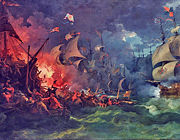
Defeat of the Spanish Armada
Drake was vice admiral in command of the English fleet (under Lord Howard of Effingham) when it overcame the Spanish Armada that was attempting to invade England in 1588. As the English fleet pursued the Armada up the English Channel in closing darkness, Drake put duty second and captured the Spanish galleon Rosario, along with Admiral Pedro de Valdés and all his crew. The Spanish ship was known to be carrying substantial funds to pay the Spanish Army in the Low Countries. Drake's ship had been leading the English pursuit of the Armada by means of a lantern. By extinguishing this for the capture, Drake put the fleet into disarray overnight. This exemplified Drake's ability as a privateer, suspending strategic purpose if a tactical profit were offered.
On the night of July 29, along with Howard, Drake organised fire-ships, causing the majority of the Spanish captains to break formation and sail out of Calais into the open sea. The next day, Drake was present at the Battle of Gravelines.
| “ | Coming up to them, there has passed some common shot between some of our fleet and some of them; and as far as we perceive, they are determined to sell their lives with blows. | ” |
|
— Letter to Admiral Henry Seymour, after coming upon part of the Spanish Armada, written aboard the Revenge on July 31, 1588 ( July 21, 1588 O.S.) |
||
The most famous (but probably apocryphal) anecdote about Drake relates that, prior to the battle, he was playing a game of bowls on Plymouth Hoe. On being warned of the approach of the Spanish fleet, Drake is said to have remarked that there was plenty of time to finish the game and still beat the Spaniards. There is no known eyewitness account of this incident and the earliest retelling of it was printed 37 years later. Adverse winds and currents caused some delay in the launching of the English fleet as the Spanish drew nearer so it is easy to see how a popular myth of Drake's cavalier attitude to the Spanish threat may have originated.
Drake-Norris Expedition
In 1589, the year after defeating the Armada, Drake and Sir John Norreys were given three tasks. They were ordered to first seek out and destroy the remaining ships, second they were to support the rebels in Lisbon, Portugal against King Philip II (king of Spain and Portugal then), and third they were to take the Azores if possible. Drake and Norreys destroyed a few ships in the harbour of La Coruña in Spain but lost more than 12,000 lives and 20 ships. This delayed Drake, and he was forced to forego hunting the rest of the surviving ships and head on to Lisbon.
Final years
Drake's seafaring career continued into his mid-fifties. In 1595, following a disastrous campaign against Spanish America, where he suffered several defeats in a row, he unsuccessfully attacked San Juan, Puerto Rico. The Spanish gunners from El Morro Castle shot a cannonball through the cabin of Drake's flagship, but he survived. In 1596, he died of dysentery, at age 56 while anchored off the coast of Puerto Bello, Panama where some Spanish treasure ships had sought shelter. He was buried at sea in a lead coffin, near Portobelo.
Cultural impact
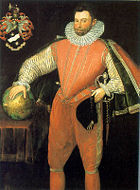
Drake's exploits as an explorer have become an enduring part of the world's consciousness, particularly in Europe. Numerous stories and fictional adaptations of his adventures exist to this day. Considered a hero in England, it is said that if England is ever in peril, beating Drake's Drum will cause Drake to return to save the country. This is a variation of the sleeping hero folktale.
Drake's adventures, though less known in the United States, still have some effect. For instance, a major east-west road in Marin County, California is named Sir Francis Drake Boulevard. It connects Point San Quentin on San Francisco Bay with Point Reyes and Drakes Bay. Each end is near a site considered by some to be Drake's landing place. Along that road, in San Anselmo, is Sir Francis Drake High School, the only high school in the United States named after him. A large hotel in Union Square, San Francisco bears his name.
Drake's will was the focus of a vast confidence scheme which Oscar Hartzell perpetrated in the 1920s and 1930s. He convinced thousands of people, mostly in the American Midwest, that Drake's fortune was being held by the British government, and had compounded to a huge amount. If their last name was Drake they might be eligible for a share if they paid Hartzell to be their agent. The swindle continued until a copy of Drake's will was brought to Hartzell's mail fraud trial and he was convicted and imprisoned.
In 1960 the television series Sir Francis Drake debuted on ITV, starring Terence Morgan in the title role.
Uncharted: Drake's Fortune, a video game for the PlayStation 3 console, features the character Nathan Drake, a fictional descendant of Francis Drake in search of his ancestor's lost treasures of El Dorado. The storyline follows clues supposedly left behind, and examines what mysteries lie within the history of Drake, and his death.
Drake appears as something of a deus ex machina in The Adventures & Brave Deeds Of The Ship's Cat On The Spanish Maine: Together With The Most Lamentable Losse Of The Alcestis & Triumphant Firing Of The Port Of Chagres, a children's book by Richard Adams.
Drake lends his name to the alternative rock band Sir Francis Drake and the Spanish Armada of Berwyn, Pennsylvania.
Controversies
Slave Trading
Drake accompanied his second cousin Sir John Hawkins in making the third English slave-trading expeditions, making fortunes through the abduction and transportation of West African people, and then exchanging them for high-value goods. The first Englishman recorded to have taken slaves from Africa was John Lok, a London trader who, in 1555, brought to England five slaves from Guinea. A second London trader taking slaves at that time was William Towerson whose fleet sailed into Plymouth following his 1556 voyage to Africa and from Plymouth on his 1557 voyage. Despite the exploits of Lok and Towerson, John Hawkins of Plymouth is widely acknowledged to be the pioneer of the English slave trade.
Around 1563 Drake first sailed west to the Spanish Main, on a ship owned and commanded by his uncle John Hawkins, with a cargo of people forcibly removed from the coast of West Africa. The Englishmen sold their African captives into slavery in Spanish plantations. These profitable activities (which he continued) undermine the tendency to view Drake as simply an untarnished English hero. Although slavery was legal throughout the world at the time, its expansion by Hawkins and Drake is now widely seen as a great blot upon their records. In general, the kidnapping and forced transportation of people was considered to be a criminal offence under English law at the time, although legal protection did not necessarily extend to slaves, non-Protestants or criminals. Hawkins' own account of his actions (in which Drake took part) cites two sources for their victims. One was military attacks on African towns and villages (with the assistance of rival African warlords). The other was privateer actions against Portuguese slave ships. Britain's slave trade later came to be regarded as a terrible stain on the moral history of the nation, and Drake's role in laying the technical, legal and political foundations for the slave trade cannot be overlooked.
Conflict in the Caribbean
During his early days as a slave-trader, Drake took an immediate dislike to the Spanish, at least in part due to their Catholicism and inherent mistrust of non-Spaniards. His hostility is said to have increased over an incident at San Juan de Ulua in 1568, when, while delivering his African victims, a Spanish fleet took him by surprise. Although he was in an enemy port, it was conventional for the Spanish to 'surrender' for a few hours in order to purchase control of the kidnap victims. Thus it was unusual for a fleet of enemy warships to appear out of the blue. Drake survived the attack largely because of his ability to swim. From then on, he devoted his life to working against the Spanish Empire; the Spanish considered him an outlaw pirate (see also Piracy in the Caribbean), but to England he was simply a sailor and privateer. On his second such voyage, he fought a battle against Spanish forces that cost many English lives but earned him the favour of Queen Elizabeth
The most celebrated of Drake's adventures along the Spanish Main was his capture of the Spanish Silver Train at Nombre de Dios in March 1573. With a crew including many French privateers and Maroons — African slaves who had escaped the Spanish — Drake raided the waters around Darien (in modern Panama) and tracked the Silver Train to the nearby port of Nombre de Dios. He made off with a fortune in gold, but had to leave behind another fortune in silver, because it was too heavy to carry back to England. It was during this expedition that he climbed a high tree in the central mountains of the Isthmus of Panama and thus became the first Englishman to see the Pacific Ocean. He remarked as he saw it that he hoped one day an Englishman would be able to sail it -- which he would do years later as part of his circumnavigation of the world.
When Drake returned to Plymouth on August 9, 1573, a mere thirty Englishmen returned with him, every one of them rich for life. However, Queen Elizabeth, who had up to this point sponsored and encouraged Drake's raids, signed a temporary truce with King Philip II of Spain and so was unable to acknowledge Drake's accomplishment officially.
Though considered a hero in England in his own time and regarded as a significant historical figure; Spanish history perceives him as a mere pirate who mercilessly plundered Spanish New World shipping and harbours. Drake, "el Draque", as he was referred to by the Spanish, was used as a bogeyman for centuries after his "vicious" raids.
Atrocities in Ireland
In 1575 Drake was present at Rathlin Island, part of the English plantation effort in Ulster when 600 men, women, and children were massacred after surrendering.
Francis Drake was in charge of the ships which transported John Norreys' Troops to Rathlin Island, commanding a small frigate called "Falcon", with a total complement of 25. At the time of the massacre, he was charged with the task of keeping Scottish vessels from bringing reinforcements to Rathlin Island. The people who were massacred were, in fact, the families of Sorley Boy MacDonnell's followers.
Execution of Thomas Doughty
| “ | And after this holy repast, they dined also at the same table together, as cheerfully, in sobriety, as ever in their lives they had done aforetime, each cheering up the other, and taking their leave, by drinking each to other, as if some journey only had been in hand. | ” |
|
—Francis Fletcher in his account of the Communion |
||
In 1578, Drake accused his co-commander Thomas Doughty of witchcraft in a shipboard trial. Doughty was charged with mutiny and treason. Drake then denied his requests to see Drake's commission from the Queen to carry out such acts and was denied a trial in England. The two main pieces of evidence against Doughty were the testimony of the ship's carpenter, Edward Bright and also that Doughty admitted to telling Lord William Burghley of the voyage. Drake consented to his request of Communion and dined with him. Thomas Doughty was beheaded on July 2nd 1578.
